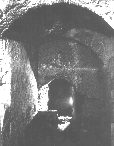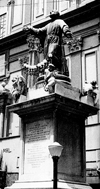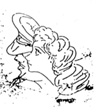|
|

NAPOLI
SOTTERRANEA the cisterns/ to cover (via Tribunali, S. Anna di Palazzo)
catacombs (S. Gennaro, S. Gaudioso, Fontanelle, Purgatorio ad Arco)>
Greco-Roman ruins (san Lorenzo, piazza Bellini, the Seiano grotto ).
|
|
|
 The
underground city. The
underground city.
From the sea to the hill, the city lends itself well to underground
tourist strolls that are mid-way between archeology and cave exploration.
Particularly suggestive are the wartime shelters built by transforming
the twisting mazes of the ancient city aqueduct. These waterways
became roads to safety when, in 1941-43, wells were turned into
numerous narrow stairways; the cisterns became bomb shelters equipped
with electric power, small folding beds and lavatories. Thousands
of people found refuge in the ancient water tanks.
 · To experience a pleasant and unusual excursion
underground, simply go down 150 steps on Via dei Tribunali, off
the church of San Paolo Maggiore near San
Gaetano Square. The walk, which lasts about two hours and is
recommended by Napoli Sotterranea, the Neapolitan Speleological
Association, combines the charm of Roman antiquity with the drama
of WWII. Going down to about 30-40 meters below current street level,
the visitor winds up in the ancient Roman aqueduct, a dense network
of tunnels and cisterns dug into the tuff rock to distribute water
from the headwaters of the Serino River to the city. It is an underground
area of 10.000 m2 from Via Anticaglia to Via S. Gregorio Armeno,
honeycombed with a myriad of tuff tunnels added through the centuries
to ensure that every building above had its own well that was connected
to the cisterns. Along this very interesting route, at times with
only torches and candles to light the way, the visitor even has
the chance to appreciate botanical experiments.
· To experience a pleasant and unusual excursion
underground, simply go down 150 steps on Via dei Tribunali, off
the church of San Paolo Maggiore near San
Gaetano Square. The walk, which lasts about two hours and is
recommended by Napoli Sotterranea, the Neapolitan Speleological
Association, combines the charm of Roman antiquity with the drama
of WWII. Going down to about 30-40 meters below current street level,
the visitor winds up in the ancient Roman aqueduct, a dense network
of tunnels and cisterns dug into the tuff rock to distribute water
from the headwaters of the Serino River to the city. It is an underground
area of 10.000 m2 from Via Anticaglia to Via S. Gregorio Armeno,
honeycombed with a myriad of tuff tunnels added through the centuries
to ensure that every building above had its own well that was connected
to the cisterns. Along this very interesting route, at times with
only torches and candles to light the way, the visitor even has
the chance to appreciate botanical experiments.
 · A similar structure has been recovered by the
Laes Association on Via Sant'Anna di Palazzo. Visitors, after going
down a spiral stairway, go 40 meters further down for a two-hour
walk in the bowels of the Quartieri
Spagnoli [Spanish Quarter]. It is a shelter of more than 3,000
m2 where about 4,000 people, at any one time, found refuge in the
various passageways and tunnels. There are ceramic electric insulators,
seats in cement, and lavatories, all installed to convert the cisterns
into shelters. On the plaster-covered walls the visitor finds an
interesting collection of graffiti, bearing witness to the atmosphere
of the time, one of drama but at times cheerful-a period of life
lived underground. There are stylized portraits of the Hitler, Hirohito
and Mussolini trio; and pictures of women's profiles next to those
of uniformed men mingle with the shape of aviators in uniform or
with pictures of young models either in bridal or in evening gowns,
or with characters from comic strips like Mr. Bonaventura (for those
who recall the comic strips from the Corriere dei Piccoli, ["Children's
Courier"] a children's comic book, quite well known during that
period). Then, there are halls by theme: the "war" room, depicting
real sea and air battles as well as news stories such as the one
related to the Italian submarine "Topazio" sunk in 1943 by Allied
Forces in the Mediterranean Sea; or the story concerning the air
raid on the city by the "accursed hunchback", the "Savoia Marchetti"
bomber that used to unload bombs according to "soccer game strategy";
or even the "wedding" room, where you can read the inscription "Anna
and Renzo are getting wed on September 20th", which is just a step
away from a small corner that someone, a bit more demanding, booked:
"reserved for Mr. Campagna".
· A similar structure has been recovered by the
Laes Association on Via Sant'Anna di Palazzo. Visitors, after going
down a spiral stairway, go 40 meters further down for a two-hour
walk in the bowels of the Quartieri
Spagnoli [Spanish Quarter]. It is a shelter of more than 3,000
m2 where about 4,000 people, at any one time, found refuge in the
various passageways and tunnels. There are ceramic electric insulators,
seats in cement, and lavatories, all installed to convert the cisterns
into shelters. On the plaster-covered walls the visitor finds an
interesting collection of graffiti, bearing witness to the atmosphere
of the time, one of drama but at times cheerful-a period of life
lived underground. There are stylized portraits of the Hitler, Hirohito
and Mussolini trio; and pictures of women's profiles next to those
of uniformed men mingle with the shape of aviators in uniform or
with pictures of young models either in bridal or in evening gowns,
or with characters from comic strips like Mr. Bonaventura (for those
who recall the comic strips from the Corriere dei Piccoli, ["Children's
Courier"] a children's comic book, quite well known during that
period). Then, there are halls by theme: the "war" room, depicting
real sea and air battles as well as news stories such as the one
related to the Italian submarine "Topazio" sunk in 1943 by Allied
Forces in the Mediterranean Sea; or the story concerning the air
raid on the city by the "accursed hunchback", the "Savoia Marchetti"
bomber that used to unload bombs according to "soccer game strategy";
or even the "wedding" room, where you can read the inscription "Anna
and Renzo are getting wed on September 20th", which is just a step
away from a small corner that someone, a bit more demanding, booked:
"reserved for Mr. Campagna".
|
 Catacombs. Catacombs.
The city beneath Naples is not just aqueducts and Greco-Roman excavation
sites, but also Paleochristian chambers: hidden places of a time past
and an expression of unique architectural, artistic and spiritual
heritage. Groups of catacombs abound, especially in the Eastern area
of the city, where they proliferated between the 2nd and 9th century
A.D. with the beginning and development of Christianity and that faith's
great need for well-protected areas to bury its dead and freely practice
its own religious rites. Romans were prohibited access to this area,
and Christians were protected from the persecutions inflicted by Imperial
laws. Authentic underground labyrinths, dug in the tender tuff rock
of the Partenopean hills, are simply a series of tunnel spaces following
one another. The dug storage tanks that combine geometric precision
with expressive freedom in an explosion of architectural forms, and
the series of spaces where the walls are decorated by frescoes, all
bear witness to the considerable figurative culture that became widespread
in that period.
next
page |
| Photos:
courtesy of Monica Biancardi, Archeological complex of |
| San Lorenzo Maggiore,
Libero De Cunzo, Laes Association, | | Lucia
Pagano, Renato Quaranta, Sagep. |
|
|
|
